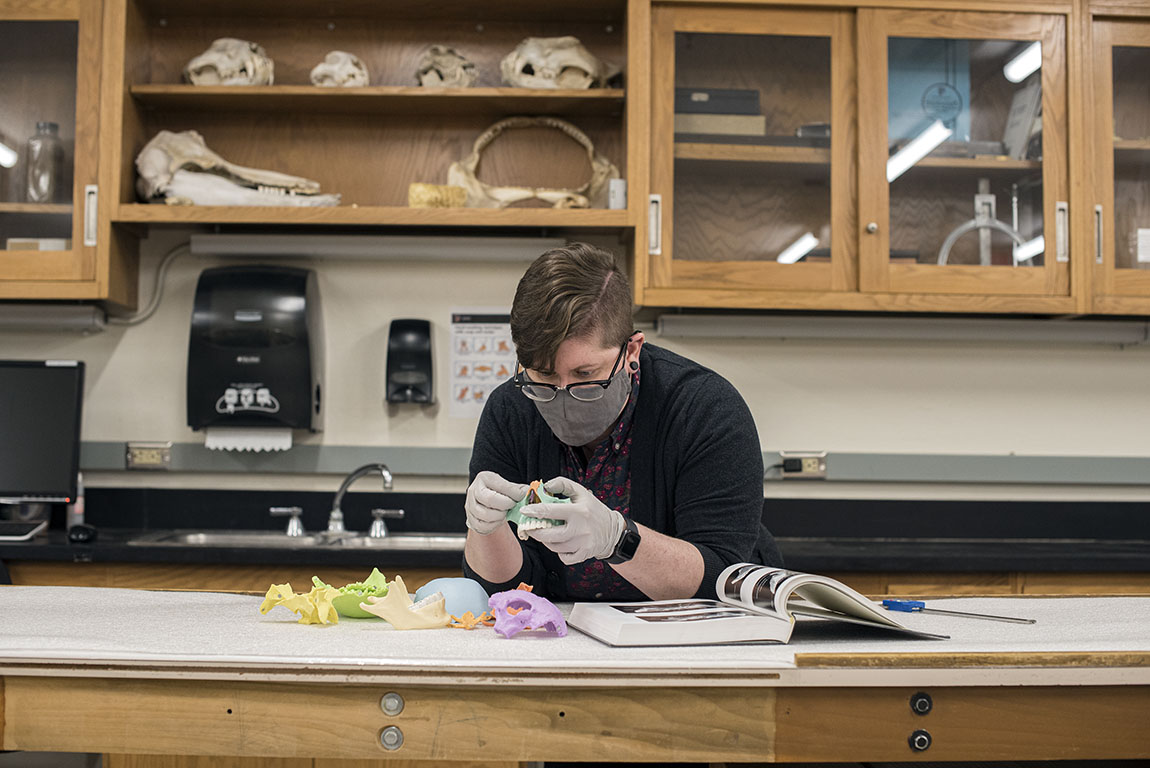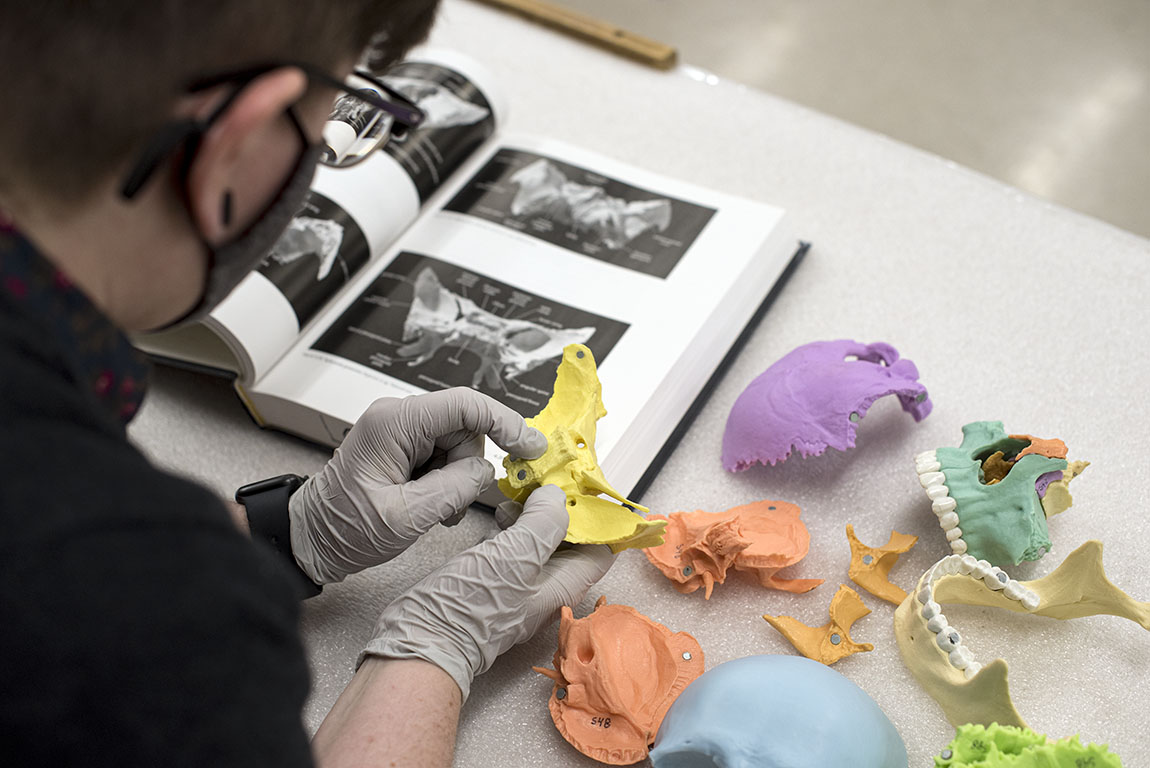Right Down to the Bones
Alex Denning ’09 oversees the University of New Mexico’s Laboratory of Human Osteology, which houses the skeletal remains of between 3,000 and 5,000 individuals.By: Meghan Kita Friday, October 23, 2020 01:38 PM
 Alex Denning '09 consults an osteology reference alongside replica bones. Photos by Karen E. Price
Alex Denning '09 consults an osteology reference alongside replica bones. Photos by Karen E. PriceAmong the medical artifacts housed in Philadelphia’s Mütter Museum are the preserved livers of Chang and Eng Bunker, twin brothers born in 1811 who were conjoined at the abdomen. (The Bunkers were Siamese-American, and out of their fame came the term “Siamese twins.”) Their livers were their only organs that were connected, “which was unfortunate, because only one of them was an alcoholic,” says Alex Denning ’09.
Denning, who is currently the senior collections manager for human osteology at the University of New Mexico’s Maxwell Museum of Anthropology, interned at the Mütter starting in 2014 as their first foray into museum work. Their role involved maintaining wet specimens such as the Bunker liver: replacing fluids, affixing specimens to new mounts and so on.
Prior to that experience, Denning had primarily worked as a field archaeologist. They had studied anthropology at Muhlenberg before earning a master’s degree in human osteology (the study of the structure and function of the skeleton) and paleopathology (the study of the pathological conditions found in ancient remains) from the United Kingdom’s University of Bradford in 2012. They used that training to get a job with a cultural resource management company in Pennsylvania.
“If there is a construction project or power lines or pipelines going in, just like environmental studies, archaeological studies need to happen as well,” Denning says. “It’s mostly carrying lots of heavy gear through the woods and up hills.”
Denning occasionally stumbled upon some small sites, but most of the work involved digging without finding anything noteworthy. That’s why they contacted the Mütter—they knew of it from growing up outside Philadelphia—to see if any opportunities were available for physical anthropologists or human osteologists. When the Mütter offered an internship involving a slightly different skill set, Denning jumped on it and discovered something important.
“Working with more soft tissue as an intern at the Mütter, I was like, ‘Okay, I have the stomach for working with this,’” they say. So, they took on a side job in a hospital morgue as a medical examiner assistant, which involves “preparing a decedent before an autopsy, assisting during the autopsy and collecting all the fluid and tissue samples they analyze for pathology and histology.”
The Mütter and the morgue gave Denning the right experience for a long-term, project-based position at Harvard Medical School’s Warren Anatomical Museum, which held about 900 wet specimens that hadn’t been touched in 80 to 100 years. Starting in spring 2015, Denning worked through the specimens, researching how they came to be and doing preservation and documentation work. Meanwhile, they earned their graduate certificate in museum studies via Harvard’s extension school.
After about three years, that project ended. They were working in Boston’s Office of the Chief Medical Examiner when they got a call about the Maxwell Museum of Anthropology job, “one of those jobs that you dream about and never really comes around,” Denning says. “It pretty much ticked all of the boxes.”

Since June 2019, Denning has overseen the Maxwell’s Laboratory of Human Osteology, which houses the skeletal remains of between 3,000 and 5,000 individuals. The lab has three collections: a prehistoric collection of archaeological remains, a forensic collection (of the local medical investigator’s “Doe” cases) and a collection from the lab’s skeletal donor program. None of these collections are open to the public—they exist only for research purposes.
“One of the things I like about my job is there isn’t really a standard day,” Denning says. They ensure that the collections are maintained and cared for, that researchers are able to access the material and that the donor specimens are processed and documented.
Of the few body donation programs in the country that are specifically skeletal, the University of New Mexico’s is the only one that does not utilize natural processes. Instead, the body is taken to the local medical examiner’s facilities, where Denning removes as much soft tissue as possible before beginning the process of “wet maceration,” which takes about a month.
“We have a large kettle that we maintain at a certain temperature that will aid in removing the rest of the soft tissue,” Denning says. “We do that until we have a nice, clean skeleton.”
A winding career path brought Denning to a place where their focus is on their primary interest and area of expertise—bones. Bones stand the test of time, surviving centuries after the last bits of soft tissue have decomposed. By examining skulls, archaeologists can deduce which population a person came from. Archaeologists can see whether a person had diseases like syphilis, leprosy, scurvy, cancer or tuberculosis just by examining their bones.
“You can get a fair amount of information even from just one bone, to start reconstructing someone’s life history just from that,” Denning says. “While this work might not be for everyone, the collection that I care for is invaluable to the field and to researchers who are seeking to learn about humanity from a biological perspective.”
